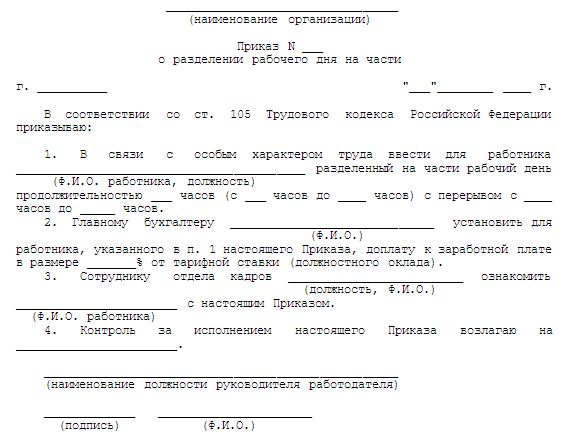The employer independently decides on what schedule his hired specialists will work. Often requires separation into parts of the working day, and usually this need is due to various changes in the production activities of the company. This procedure consists in the fact that the change of employee is divided into several parts. Small breaks are provided between these parts.
The essence of the regime
An irregular working day is used by many company executives, and it is most often found in manufacturing enterprises. With the division of the working day, it is possible to effectively manage labor resources.
The duration of the parts of work and rest is established on the basis of an agreement between the employee and the employer. But the total length of the working day cannot exceed the norm in law.
The law does not contain information on how many minimum or maximum parts a working day of a hired specialist can be divided during one shift. Most often, company leaders prefer to divide the shift into two parts, as a result of which a single break is formed between them. Its duration can vary from 1 to 3 hours.

When is separation allowed?
According to the Labor Code of the Russian Federation, dividing a working day into parts is allowed only when certain requirements are taken into account. The procedure can be performed in the following situations:
- labor activity is specific in nature, for example, work in schools or other institutions where students not only study, but also live permanently;
- in the company, workers are confronted with different labor intensities during one day, for example, in transport organizations.
In the above situations, it is imperative that one shift of an employee be divided into several parts. But after performing this process, it is not allowed that the total duration of the work exceeds the norm per day.
When dividing into parts of the working day, the employer should be guided by local laws and internal regulations. Basic information on the rules for conducting this process is contained in Article 105 of the Labor Code.
What parts is the shift divided into?
Most often, such a separation is applied to bus drivers who travel on special routes, as well as to representatives of other similar professions, as certain breaks are established between routes or performing certain work.
The break between work is maximum 3 hours, but the total amount of time that a citizen has to spend at work cannot exceed the norm established in the Labor Code.

Separation surcharge
Most often, employees are interested in payment. Dividing the working day into parts requires the head of the company to provide certain bonuses to employees for inconvenience. Such difficulties are connected with the fact that for some time citizens have to leave their workplace in order to start working again in a few hours.
Compensation can be appointed by the state or the direct employer, which is enshrined in the employment contract. For this, the head of the company issues an appropriate order to the company. Received payments cannot be part of the salary.
Most often, compensation for the division into parts of the working day is assigned to the following employees:
- women working in the village, but only on condition that their break in duration exceeds 2 hours, therefore an additional payment equal to 30% of the average earnings is assigned;
- housing and communal services workers, artisans or specialists working in the field of consumer services, and for them the surcharge is 30%;
- Heads of railway structures.
If the separation process is carried out on the basis of an industry agreement, the employer should be guided when issuing an order for the contents of this document. Surcharge cannot be lower than the size specified in this agreement.
When is a working day divided?
There are situations when the employer is required to use irregular working hours. Specific professions are determined by different regulatory documents. For example, in the Order of the Ministry of Communications, the following specialists are indicated for whom the shift is divided:
- Head of Communications
- operator engaged in the issuance or acceptance of items and telegrams;
- operators responsible for postal deliveries;
- postmen;
- letter sorter;
- electricians of equipment;
- help desk telephone operators.
The shift is mandatory for drivers, for which purpose a special provision is formed directly in the organization on the division of the working day into parts. This also includes subway workers and specialists from educational institutions in which students are around the clock. Therefore, employers must take into account the nature of the work of their employees in order to establish an optimal work schedule for them.

Drawing up an internal regulatory act
If you want to divide the working day of a certain specialist into several parts, then this procedure should be correctly executed by the head of the company. Initially, a special local act is drawn up in the company, on the basis of which an irregular working day is established.
The following information must be entered into this normative act:
- how many parts the specialist’s working day is divided into;
- for which employees of the company such changes in the work schedule are envisaged;
- total working day;
- break start and end time;
- date when the transition to a new schedule occurs;
- validity period of the new regime;
- other important points related to the work of the hired specialist.
This documentation is approved by the head of the personnel department of the company. Additionally, the act is submitted to the union for study. Union representatives may make various adjustments to this document.
As soon as the act is approved, then all employees who are affected by this documentation become familiar with its contents, and the procedure is performed against signature.

Formation of an additional agreement
Dividing the working day into parts for drivers or other hired professionals is considered a complex process involving a significant change in the working conditions of citizens. Therefore, the employer must correctly draw up such adjustments. For this, with each employee for whom the work schedule is being changed, an additional agreement to the employment contract is drawn up.
This agreement certainly states that the citizen is transferred to a divided shift. For this, the appropriate order is issued in advance by the head of the company.
Features of work
The division of the working day into parts has many nuances. These include:
- any citizen working officially has the right to a break, the duration of which can be in the range from half an hour to two hours;
- time to be established between different parts of one shift by the head of the company;
- it is required in advance to obtain permission to split the shift from the union;
- without fail, an internal act is issued in the company, on the basis of which the division of working hours of employees into several parts is carried out;
- the employer must make sure that the rights and interests of the employees of the company are fully respected.
If union representatives agree with all changes, they must draw up written consent within 5 days after receiving the act. If there is no answer during this time period, the company may approve the act without the consent of the trade union body.
The union may amend if any clauses of an existing act violate the rights or interests of employees.

Paid and unpaid periods
The employer can determine for himself what the internal routine of his employees will be. Therefore, a work shift can be split into a different number of parts. According to the law, only periods intended for rest and meals can be paid by management, and in other situations, payment is not provided.
Based on Art. 108 TC indicates that all people should have a break for food. It is installed at any time during the shift, and at least it is equal to 30 minutes. The employer may not pay this period.
There are paid breaks, for example, if a specialist works in the cold, then periodically he should rest in a heated room. The employer must not only pay for these breaks, but also provide conditions for a comfortable stay.
If the existing workday is divided for existing workers, then employers often charge bonuses to reduce the negative consequences of such changes. They pay tax and deduct funds to various funds.
How is work paid?
A divided labor shift has several payment features. Therefore, the head of the company takes into account the following nuances:
- long breaks between separate parts of the shift are not paid, unless otherwise provided by the employment contract or an additional agreement drawn up between the director and the hired specialist;
- to compensate for the inconvenience encountered by citizens, it is required to assign an additional payment for separation;
- based on Art. 149 TC, the amount of such compensation is determined by the direct manager of the company, which takes into account the provisions of the employment contract and the supplementary agreement, as well as regulatory acts of the company and the state;
- these payments cannot be part of the salary, as they are reckoned solely as compensation.
Practice shows that company executives rarely offer compensation to their employees.

What documents are made up?
Dividing into parts of the working day is considered a complex process, during which the head of the company is obliged to prepare many different documents. They necessarily include:
- Internal regulatory act. The rules for its preparation are given in Art. 22 and Art. 105 Labor Code of the Russian Federation. With its help, it is possible to make the necessary changes to the employment contract of company employees. It indicates the exact conditions, terms and numbers, on the basis of which the crushing of the working day occurs. The number of divisions, the exact time and duration of the breaks, as well as the size of the surcharge, if it is appointed by the director, are given.
- Permission from the union. It is compiled within 5 days after the receipt of a sample normative act, on the basis of which changes will be made to the employees' labor contract. If during this period the document is not drawn up, the company has the right to make the necessary changes to the labor shift without the consent of the union.
- The schedule for dividing the working day into parts. Based on this document, all employees for whom changes are made get acquainted with the mode of their future work. Usually a schedule is drawn up for the entire company, and it’s important to use examples during the formation of this document.The division of the working day into parts should not affect the rights and interests of employees.
- Additional agreement to labor contracts. Since the division of the work shift leads to a significant change in working conditions, such adjustments will certainly be officially recorded. For this, an additional agreement is drawn up with each employee. It indicates what parts the shift is divided into, what kind of surcharge is assigned for it, and also other significant conditions are prescribed.
The absence of even one of the above documents is the basis for the forcible cancellation of the decision of the management of the company by the labor inspectorate or court.

What should employees do when their rights are violated?
Often, the working day of citizens is divided by the employer into parts with numerous violations. For example, the rights of workers are not taken into account or permission from the union is not requested. Under such conditions, hired professionals can use the following methods to solve the problem:
- filing a complaint with the labor inspectorate or prosecutor's office;
- appeal to union representatives to influence the employer by various methods or contact government organizations on behalf of workers;
- filing a lawsuit, and the court has the right not only to cancel the decision taken by the employer, but even to recover compensation for moral damage from it.
If each employee will understand his rights and obligations, he will be able to defend his interests in court or when applying to state supervisory institutions.
Conclusion
For many workers, a separation of a work shift into several parts is required. The process should be formalized with the simultaneous preparation of various official documents.
Long breaks are not paid by the employer, but he may charge a supplement for specialists, represented by compensation. She cannot be part of the salary.
